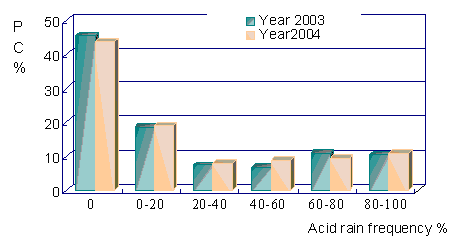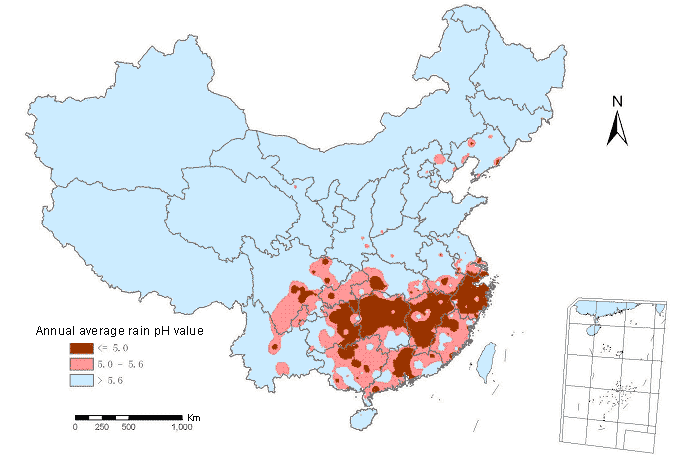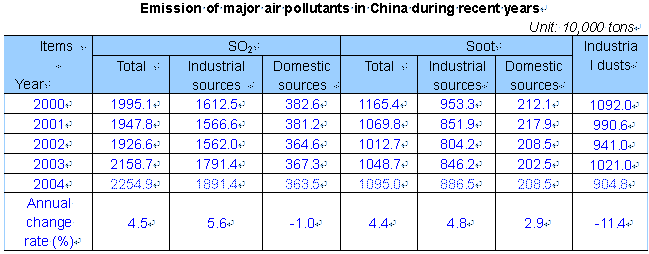
Report On the State
of the Environment In China
2 0 0 4
Atmospheric Environment
General Situation
The overall urban air quality across China was basically the same as that of 2003 with certain improvement in some cities with very heavy air pollution. The percentage of cities failing to meet Grade III air quality standard decreased, but so did the percentage of cities meeting Grade II air quality standard. Among the 342 cities under air quality monitoring in 2004, 132 cities met Grade II standard for ambient air quality (the standard for resident areas), accounting for 38.6%, 3.1 percentages points lower than that of 2003. 141 reached Grade III standard, taking up 41.2% and 9.7 percentages points higher than that of 2003; 69 cities had air quality worse than Grade III, accounting for 20.2%, 6.6 percentage points drop than that of the previous year.
The percentage of urban population with air quality meeting Grade II standard was 33.1% of all the monitored cities, 3.3 percentage points lower than that of 2003. The remaining 66.9% urban citizens were exposed to the air inferior to Grade II quality standard.
(Note: ">"in the figure means failing to meet Grade III standard.)

Percentage comparison of urban air quality at different quality standard in 2003 and 2004

Percentages of the population exposed to air at different qualities

Big cities and metropolises with a population exceeding one million usually had the highest failing rate in meeting air quality standard in terms of major pollutants such as SO2 and particulate matters. As a result, they had a low up-to-standard percentage in terms of urban air quality.
Major pollutants in the air: Particulate matters remained as the prime pollutant affecting air quality. In general, things turned to be better than the previous year. The concentration of particulate matters of 46.8% of the cities exceeded GradeⅡstandard, 1.2 percentage points up than that of last year. 14.3% of the cities failed to meet Grade Ⅲ air quality standard, 6.9 percentage points drop than that of 2003. The cities subject to the heaviest particulate pollution were mainly in such provinces as Shanxi, Inner Mongolia, Liaoning, Henan, Hunan, Sichuan and other provinces or autonomous regions in northwestern China.

Comparison of the percentage of cities(PC) with particulate concentration at different level in 2003 and 2004

In 74.3% of the cities in mainland China, the annual average concentration of SO2 met Grade Ⅱstandard (0.06 mg/m3), similar to that of the previous year. 9.1% of the cities saw the concentration over GradeⅢ(0.10g/m3) standard, 3 percentage points lower than that of last year. The cities heavily polluted by SO2 were mainly in such provinces or municipalities as Shanxi, Hebei, Henan, Hunan, Hubei, Yunnan, Inner Mongolia, Gansu, Guizhou, Guangxi, Sichuan and Chongqing.

Percentage of cities (PC) with different levels of SO2 concentration

NO2 concentration in all those cities met GradeⅡquality standard, however, it was relatively higher in big cities such as Beijing, Guangzhou, Shenzhen, Shanghai and Chongqing.
SO2 pollution in the 'Two Control Zones'. In the Sulphur Dioxide Pollution Control Zone, 40.6% of the cities met GradeⅡstandard in terms of SO2
annual average concentration, 1.5 percentage points higher than that of the previous year. 59.4% of them failed to meet GradeⅡstandard, among which 19 cities could not meet Grade Ⅲ standard, accounting for 29.7% of the total and 6.2 percentage points lower than that of 2003. In the Acid Rain Control Zone, 69.4% of those cities witnessed annual SO2
average concentration meeting GradeⅡquality standard, 5.6 percentage points lower than that of 2003; 7.2% of them failed to meet Grade Ⅲ standard, 3.1 percentage points lower than that of 2003. In the SO2
Pollution Control Zone, SO2 pollution was alleviated to some extent in part of the heavily polluted cities, whereas in the Acid Rain Control Zones, the percentage of cities meeting SO2
concentration standard fell down.


Comparison of SO2 pollution level of the ‘Two Control Zones’ in 2003 and 2004
Note: “MS” stands for meeting the standard
Air quality in key cities on pollution prevention and
control. Of the 113 key cities on air pollution prevention and control, 33 cities met GradeⅡair qualities standard, taking up 29.2%. 51 met Grade Ⅲ standard, accounting for 45.1%; 29 experienced air quality worse than Grade Ⅲ, taking up 25.7% of the total. Compared with last year, the number of cities meeting air quality standard was declined by 4, but the number of cities with air quality worse than Grade Ⅲ standard was cut down by 7.
20 out of 47 national key environmental protection cities witnessed their air quality meeting GradeⅡstandard, 21 met Grade Ⅲ standard and 6 were exposed to air inferior to Grade Ⅲ standard.


Comparison of comprehensive pollution indexes among the 47 key environmental protection cities
Acid rain: In 2004, the average annual pH value of precipitation in 527 cities (counties) across the country ranged from 3.05 (Jishou city, Hunan Province) to 8.4 (Jiayuguan city, Gansu Province). Acid rain occurred in 298 cities, 56.5% of all cities monitored. The average annual pH value of precipitation in 218 cities was below 5.6, taking up 41.4% of the total. Among them, the rain pH value of Changsha, Changde and Jishou in Hunan Province, Shaoguang in Guangdong Province and Gao’an in Jiangxi Province was less than 4.0, indicating high acidity of the precipitation. 30.1% of all the cities had acid rain incidence over 40%, among which the incidence of acid rain of Changde of Hunan Province, Dexing of Jiangxi Province, Lishui, Anji and Kaihua of Zhejiang Province was at 100%.

Percentage of cities with different acidities of their precipitation in 2003 and 2004

Percentage of cities with different frequencies of acid rain occurrence
In comparison with the previous year, the number of cities that experienced acid rain rose by 2.1 percentage points; the percentage of cities with annual rain pH value equal to 5.6 or below increased by 4 percentage points. Among them, cities with rain pH value less than 4.5 rose by 2 percentage points. The percentage of cities with acid rain incidence exceeding 80% was up by 1.6 percentage points. The percentages of cities with both low annual average rain pH value and high frequency of acid rain occurrence rose compared with that of 2003, indicating that acid rain pollution had intensified.
The distribution of acid rain areas was basically stable. In 2004 the cities with annual average rain pH value below 5.6 (acid rain) mainly concentrated in Central China, Southwest China, East China and South China. Acid rain pollution in Central China was the most serious, with 58.3% of the cities in those regions seeing an annual average pH value of precipitation equal to 5.6 or below and 21.4% having a frequency of acid rain occurrence over 80%. Hunan Province and Jiangxi Province suffered most serious acid rain pollution. The South China Acid Rain Zone refers to southeast part of Guangdong province that was centered by Pearl River Delta and east Guangxi Autonomous Region. 58.9% of the cities there witnessed annual average pH value below 5.6; acid rain pollution in this region deteriorated compared with 2003. The Southwest China Acid Rain Zone was focused on Yibin, Nanchong of Sichuan Province, Zunyi of Guizhou Province and Chongqing Municipality. Annual average pH values of precipitation in 49.0% of the cities in the zone were less than 5.6. The acid rain pollution was alleviated to certain extent in comparison with that of the previous year. The East China Acid Rain Zone covered a wide area including Southern Jiangsu Province, the entire Zhejiang Province, coastal areas of Fujian Province and Shanghai Municipality. The proportion of cities experiencing high frequency of acid rain occurrences (≥80%) and high precipitation acidity(pH≤4.5)was second only to the Central China Acid Rain Zone, which was 21.0% and 14.6% respectively. The annual average pH value of precipitation was under 5.6 in the following cities of North China: Beijing, Tianjin, Qinhuangdao and Chengde of Hebei Province, Houma of Shanxi Province, Dalian, Dandong, Jinzhou, Fuxin, Tieling and Huludao in Liaoning Province, Weinan and Shangluo of
Shaan'xi Province and Jinchang of Gansu Province.

Precipitation acidity distribution across China in 2004
Acid Rain Control Zones: Among the 112 cities within Acid Rain Control Zones, the annual average pH value of precipitation ranged from 3.05 (Jishou city, Hunan Province) to 7.26 (Binzhou, Hunan Province). Acid rain occurred in 101 cities, taking up 90.2% of the total. In the order of 83 cities had annual average pH value of precipitation was less than or equal to 5.6, accounting for 74.1% and 3.4 percentage points higher than that of 2003. The percentage of cities with annual average pH value under 4.5 rose by 6.4 percentage points. Among them, Shaoguang of Guangdong Province, Changsha, Changde and Jishou cities of Hunan Province witnessed pH value below 4.0. There were 67 cities with the frequency of acid rain occurrence over 40%, taking up 59.8% of the total, 6.1 percentage points higher than that of 2003. The coverage of acid rain pollution within the Acid Rain Control Zones remained largely the same, but with aggravated pollution.

Emission Amount of Major Air Pollutants
The total amount of SO2 emission was 22.549 million tons across China in 2004, among which 18.914 million tons were from industrial sources, and 3.635 million tons from domestic sources. The emission of soot was 10.95 million tons, among which 8.865 million tons were from industries and 2.085 million tons from domestic sources. The total emission of industrial dust was 9.04 million tons.

Countermeasures and Actions
【Prevention and control of vehicle exhaust emission】 China became the world fourth largest automobile producer and the third auto consumer in 2004. It manufactured 5.07 million automobiles, 17 million motorcycles and 2 million farm transport vehicles in 2004, and had accumulated 27.42 million automobiles, 79 million motorcycles and 25 million farm vehicles. Among the 310 million tons of petroleum consumed in China in 2004, one third was utilized as fuel for vehicles.
SEPA intensified its supervision over the management and supervision on new vehicles, vehicles under use and vehicle fuels. It released to the public the types of automobiles that met the national criteria for environmental protection on fifteen occasions throughout the year, and examined and approved 26,520 kinds of automobiles and engines under such criteria. From July 1, 2004,
National Vehicle Emission Standard--the StageⅡLimit for TypeⅠLight Vehicles was brought into effect across the country, while heavy vehicles meeting
National Vehicle Emission Standard--the StageⅠLimit completely ceased production.
【The tenth stage air pollution prevention and control measures in Beijing】
Beijing Municipal Government achieved the objective of air pollution control, i.e. the daily air quality of 62% of 365 days in the year met GradeⅡstandard. It was the first time that the annual average SO2
concentration of Beijing met GradeⅡnational air quality standard in the past twenty years.
1,037 coal-burning boilers had been transformed, so had over 80% of the 16,000 boilers with the capacity below 20 tons. Progress had been made in the central heating system and transformation of boilers in satellite cities and towns of the capital. In addition, Beijing Municipal Government enforced the
National Vehicle Emission Standard--the StageⅡLimit for Heavy Gas-fuel Vehicles and
Motorcycles, promulgated local standards for vehicle fuels, and washed out around 110,000 outdated vehicles. Furthermore, it also formulated environmental protection standards for construction sites and worked out emergency plans for sand and dust storms. Fourteen enterprises that had caused heavy pollution and strong public complaints were streamlined, transformed, ceased operation or closed, and 28 major polluting enterprises were urged to develop emission reduction program and receive public supervision.
Atmospheric Environment